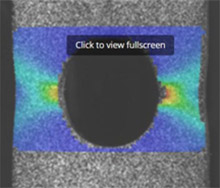Metallurgical Research & Technology 2017 Best Paper Award (July 2018)
Now in free access!
We are delighted to announce the winner of the Metallurgical Research & Technology 2017 Best Paper Award.
The Metallurgical Research & Technology Best Paper Award honors the author(s) of a paper of exceptional merit dealing with research and/or industrial aspects in metallurgy and bringing an outstanding contribution to the field. All articles published during the current year prior to the award, including Short Communications, Regular articles, Reviews and Topical contributions, can be considered for an award. The editorial committee meets every year, in December, to judge the best papers according to the criteria of originality, innovation, significance to the research community, industrial relevance, technical excellence, impact, and clarity of presentation.
The authors of the awarded articles are offered a book from the EDP Sciences catalogue. In addition, they are given the possibility to publish a press release about their work and/or their laboratory/team. Finally, the selected articles are turned into free access so that all readers can have a chance to read them.
First prize winner
Pierre Guiraldenq, Olivier Hardouin Duparc for their article "The genesis of the Schaeffler diagram in the history of stainless steels", published in Metall. Res. Technol. 114, 613 (2017).
About the article

pioneers worked
To join pieces of metals by welding has always been an important job for the metal industry, whether it is dealing with bronze, steel or any other metal family. It is important for building ships, planes, trains, pipelines, nuclear reactor vessels etc. Welding metallic alloys implies a good mastering of the phase diagrams of these alloys, either unknowingly by sheer experimental knowledge, or consciously thanks to the establishment or more and more sophisticated phase diagrams with kinetic considerations. Numerical simulations, including atomistic ab initio simulations are playing their roles on top of experimental tests, and machine learning out of big data sets will certainly come into play. We believe that it also invites us to look at how some famous pioneers worked and learned, collecting data from research and industrial applications, and, in the special case of Anton Schaeffler, progressively drawing a still useful special phase diagram out of these data. Quite similar phase diagrams can be drawn for titanium alloys.
About the author

Born in Paris, Pierre Guiraldenq did his PhD under the supervision of Professor Paul Lacombe at the École des Mines de Paris. His research dealt with radiotracers applied to the diffusion mechanisms in the solid state. He then worked as Engineer at the Compagnie des Ateliers et Forges de la Loire (Saint-Étienne), particularly for stainless steel production controlled by the Schaeffler diagram for specific applications. He has been professor at the École Centrale de Lyon and Head of the Physical Metallurgy and Materials Science Dpt. associated with CNRS. He is today emeritus professor of École Centrale.

Duparc
Olivier Hardouin Duparc was raised in the north of France, near Belgium. Curious about everything, he eventually became a researcher in the field of materials science. His research, mainly in collaboration with experimentalists, now focuses on the simulation at the atomistic level of defects such as grain boundaries in crystals. He teaches thermodynamics and phase diagrams, and electrons and materials cohesive properties. He is also strongly interested in the history of materials science. He wrote an in memoriam paper about Alan Cottrell with Jacques Friedel. He is currently a CNRS Researcher at the French École Polytechnique.
Second prize winner
Pascal Dietsch, Kévin Tihay, Antoine Bui-Van and Dominique Cornette for their article "Methodology to assess fracture during crash simulation: fracture strain criteria and their calibration", published in Metall. Res. Technol. 114, 607 (2017).
About the article

The paper introduces an experimental methodology for ductile fracture criterion identification. The originality and robustness of the approach lie on principally two aspects.
First, the failure strain measurement is performed on a set of sample geometries that cover a wide range of strain paths (or triaxiality). This direct measurement, or hybrid measurement for VDA238 provides fracture data that are not depending on the numerical parameters influence of any Finite Element Analysis Code such as mesh size, number of integrations points.
Secondly, the numerical aspects are considered through a regularization step performed on a 3-point-bending sample. The correct correlation between prediction and experimental observation has been checked thanks to crash facilities, which also constitutes an important step for the material model relevancy validation.
About the authors/group presentation
In products dedicated research centre located in Maizières-les-Metz, Crash team objective is to ensure the good understanding of steels behaviour in order to accompany the customers and help them taking the benefits of ArcelorMittal products. The team has developed a significant experience in the fields of high speed testing for high strain rate constitutive laws identification, crash testing and numerical simulation. More recently, a competency on fracture characterization and fracture criterion identification has been built. Product lab can then fully characterize a steel, model its behaviour, validate the material card thanks to crash testing on component.

Antoine Bui Van served in R&D five years long. He realized the work presented in the paper. Now, he works in the field of production.

Dominique Cornette is strongly contributing to the crash activity development in the lab for more than 20 years, first as a researcher, now through his product developments activities and expertise in crash area.


Kévin Tihay and Pascal Dietsch are currently in charge of crash activities in product centre. They contribute to the characterization and modelling of steels behaviour and pursue the development of accurate fracture prediction methodologies.

